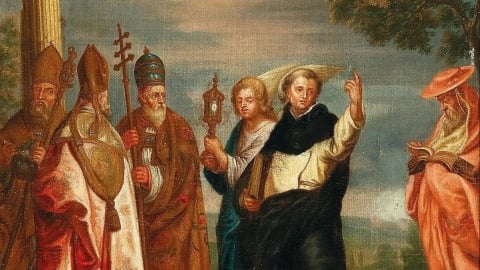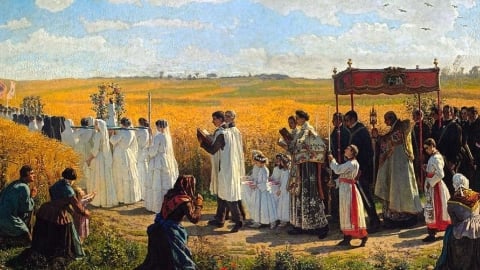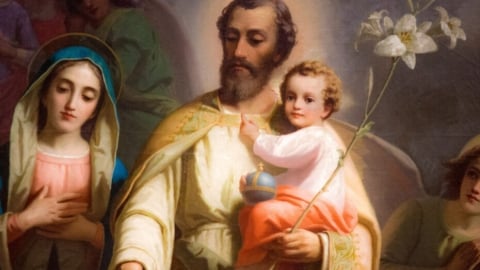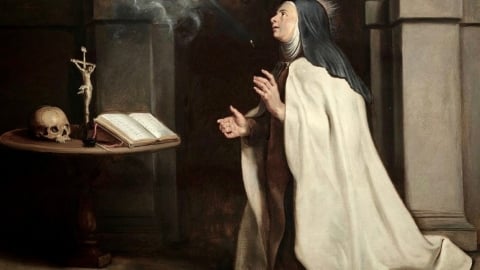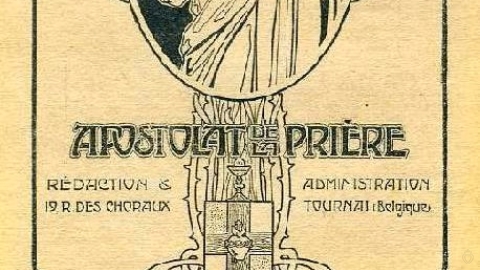Vatican Council I and the Assumption

On February 23, 1870, Joseph Benedict Dusmet, O.S.B., Archbishop of Catania, Sicily, and Louis-Marie Idea, Bishop of the Lipari Islands, introduced the postulata, or requests, of one hundred and ninety-five members of the Vatican Council for an explicit and solemn declaration and definition of the dogma of the Assumption. The nine letters containing the formal petitions to Pope Pius IX were signed respectively by 18, 113, 31, 5, 13, 2, 5, 7, and 15 Fathers of the Council. The postulatum signed by 113 Fathers of the Vatican Council, translated below, enumerates a series of arguments for the Assumption from Scripture, Tradition, and theology.
Postulatum of the Vatican Council
MOST HOLY FATHER, according to the teaching of the Apostle Mind Yom. 58, 1 Cor 15:24, 26, 54, 57, Heb. 2:14, 15, and other passages, Christ enjoyed a triple triumph over Satan, the old serpent; a victory over sin and over concupiscence and death, the results of sin, which form, as it were, the constituent parts of that triumph. In Gen. 3:15, the Mother of God is portrayed as one associated, in a unique manner, in this triumph of her Son. In accordance with the unanimous testimony of the Fathers, we are convinced that in the prophecy referred to, the Blessed Virgin is prefigured as one crowned with that same triple victory.
Consequently, this prophecy pertains to her victory over sin through the Immaculate Conception, her victory over concupiscence by her virginal motherhood, and her unique victory over the common enemy, death, through her speedy resurrection, like that of her Son. All of this received a new clarification from the natural physical union existing between Christ and His Mother. Suarez is therefore right in declaring that Jesus Christ might thus address His holy Mother: “This is the flesh from which My flesh came.”
We can also positively affirm that the body of the Blessed Virgin was, in a certain sense, the first step in the salvation of mankind, since from her blood the Body of Christ was formed, that Body which was the price of our redemption. Therefore, we must hold without a shadow of doubt, that the Blessed Virgin’s body participated uniquely in the redemption: in other words attained to early glory and immortality.
Moreover, in reference to the resurrection of the Immaculate Virgin, and her assumption into heaven, there is an ancient tradition in both the Eastern and Western Church, as is clear from the unanimous agreement of the Fathers and from uninterrupted liturgical practice. Contributing to the maintenance of this tradition are the obvious agreement of the resurrection and assumption with the other prerogatives of the Blessed Virgin, the absence of any relics, and her empty tomb. Some authors have shown hesitation, due it would seem to the decree of Pope Gelasius on the subject of apocryphal books; nevertheless, the ancient and respected opinion has met with such approval through the centuries that it is now considered theologically certain and definable as an article of faith, so that it would be a sin for any Catholic to doubt it.
In fact some important writers consider it already as an article of faith. It will be enough at this point to quote Benedict XIV. After vigorously defending the opinion he adds (Canonization, 1:42, 15) “This feast is referred to by St. Bernard in his letter 174 to the Canons of Lyons: ‘The Church assures me that this day should be held in the highest veneration, since in heaven it was an occasion of boundless joy.’” Moreover, the statements of Gregory of Tours, Andrew of Jerusalem, Pope Gregory the Great, Ildephonsus, bishop of Toledo, John Damascene, and Bernard, abbot of Clairvaux, clearly point out that the Blessed Virgin after a peaceful death was assumed at once into heaven.
There are also theological arguments to support the opinion which devoutly maintains the bodily assumption of the Blessed Virgin into heaven. These arguments are drawn from the dignity of the Mother of God, from her unsurpassed virginity, from her unique holiness superior to that of all men and angels, from her unique association and agreement with Christ her Son, and from the love He had for His exalted Mother.
Finally and this is most important, the Church not only celebrates the Assumption of the Blessed Virgin into heaven, but also has the faithful listen to the homilies of St. John Damascene and St. Bernard, in which the Assumption of the Blessed Virgin, soul and body, into heaven is stated in most eloquent terms. There seems to be absolutely no room for doubt where the Church’s teaching authority and liturgical practice are concerned.
From all this it is clear that this privilege, which plays an important role in the Marian scheme, and agrees so completely with other revealed doctrines, could not have been unknown to the Apostles, and particularly to John, and therefore reaches the Church from apostolic tradition.
In the light of these and other important considerations, brought forward by ancient sources and countless ecclesiastical writers throughout the years, we know that this devout and ancient opinion is based on solid grounds and is definable as an article of faith.
Most Holy Father, not many years ago you rendered your infallible pronouncement, long and ardently awaited by the peoples of the world, requested by the eloquent pleas of all nations, and received with enthusiasm by the bishops and the faithful, when you issued the dogmatic definition of the Immaculate Conception of the Mother of God. It is to you that we and the Christian people entrusted to our care address a most urgent appeal, that the Church may synthesize all of the glories and triumphs of God’s Mother by defining that she was taken up into heaven body and soul.
There is good reason for requesting this glorious step. Just as with her virginal foot the Blessed Virgin crushed the head of the old serpent, so also through this solemn and new manifestion of her glory, she, as the unconquered one, will crush her enemies and those of Christ her Son, who are prospering in these unhappy times. If she will turn her merciful eyes upon us, we are confident that the monstrous errors, presently rife, especially rationalism and materialism, will be quelled like the swelling waters of the ocean, and the awful vices which as in the days of Noah now contaminate the whole world, will be banished. In fact, the very enemies of the Catholic faith, following the guiding light of the Star of the Sea, and swiftly making their way back to the barque of Peter, will again form one fold under one shepherd.
Therefore, Most Holy Father, supreme representative of the priesthood and spokesman of the Catholic Church, we, the Fathers of the Vatican Council, summoned by you, prostrate at those feet of which it is written, “How wonderful are the feet of those who bring the message of peace, the message of good news,” most earnestly beg that in this sacred council, your supreme authority declare, proclaim, and define this doctrine that the Mother of God is now living in heaven with her immaculate soul and virginal body. To this end we confidently sign the petition with our own hand.
Signatures of 113 Bishops
